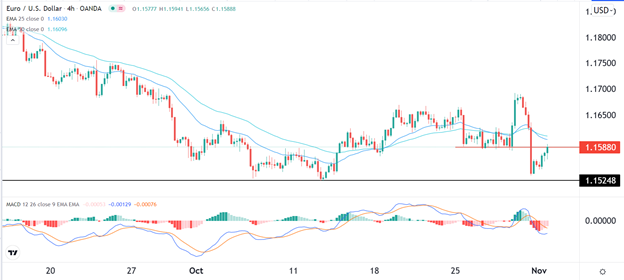Bearish View
Sell the EUR/USD and set a take-profit at 1.1524.
Add a stop-loss at 1.1650.
Timeline: 1-2 days.
Bullish View
Set a buy-stop at 1.1610 and a take-profit at 1.1700.
Add a stop-loss at 1.1550.
The EUR/USD crawled back in the overnight session as investors reflected on the relatively weak German retail sales data and American strong Manufacturing PMI numbers. The pair rose to 1.1590, which was above last Friday’s low of 1.1534.
German Retail Sales and US PMI Numbers
The German retail sector experienced a sharp weakness in September as consumers remained concerned about the rising prices.
According to Destatis, the country’s retail sales declined by 0.9% on a month-on-month basis in September after rising by 1.1% in the previous month. This decline was worse than the median estimate of a 1.8% increase.
The sales also declined by 2.5% on a year-on-year basis after they rose by 1.2% in the previous month. These numbers signal that the country’s economy is not recovering at a faster pace than expected.
The data came a few days after the European Central Bank (ECB) delivered its interest rate decision. In it, it decided to slow the pace of asset purchases as the overall economy continued to recover.
The next key mover for the EUR/USD will be the Eurozone Manufacturing PMI data that will come out on Tuesday. Based on the flash PMI data published a few days ago, analysts expect that the German Manufacturing PMI declined slightly to 58.2 while the Eurozone PMI dropped to 58.5.
Still, since the numbers are above 50, it is a sign that the sector is doing well. The key challenges that manufacturers are facing are higher costs of doing business logistics. On Monday, data from the US showed that the PMI dropped from 61.1 to 60.8. It was better than the median estimate of 60.5.
The EUR/USD will also react to the latest Federal Reserve interest rate decision scheduled for Wednesday and the non-farm payrolls (NFP) data scheduled on Friday.
EUR/USD Forecast
The EUR/USD declined sharply on Friday after the strong US PCE data. It fell to a low of 1.1534, which was slightly above October’s low of 1.1524. The pair pared back some of these losses and is trading at 1.1590. This is an important level since it struggled moving below it between November 25 and 28.
The pair also declined below the 25-day and 50-day moving averages. Therefore, I suspect that the pair will resume the bearish trend as bears target the support at 1.1524.


